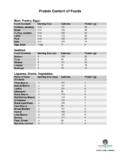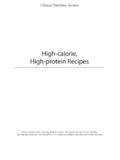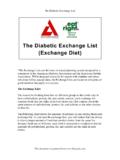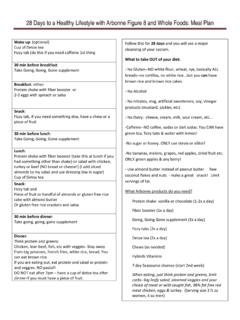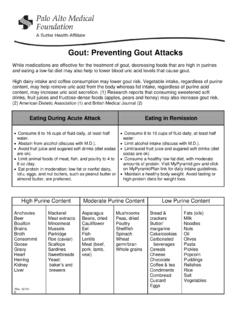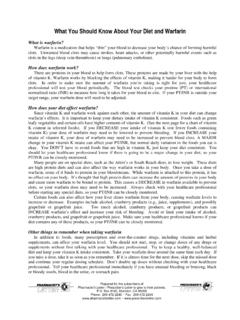Transcription of Homemade Dog Food - Cookus Interruptus
1 Homemade Dog food Thank you to Laine S. Lum, MS, RD who complied much of this information. Laine was my student and she did a very thorough investigation of feeding dogs for a class project. She is also the proud owner of a boxer. The Balance: 40-60% raw meat/protein 20-30% cooked starch 20-30% raw vegetables/fruit 40-60% Raw or Cooked Meat/Protein Options: Raw lean beef, lamb, chicken and turkey are good options. It is convenient to buy the meat pre-ground. If the meat is on the bone that is fine as long as the bone is raw. If you choose to feed raw protein, get ingredients from a source you trust. Variety is important. Don't use the same meats or other foods every week. Other suitable protein options include: eggs (raw or cooked), organ meats, sardines, cottage cheese, plain whole milk yogurt.
2 Dairy products should be used more as a supplement, less as a main ingredient. If your dog is a senior, ill or has digestive problems or if you are concerned about the risk of food borne illness from raw protein, you may want to use only cooked protein sources. Stewing or poaching meat is best. Carol White, MS, RD has a good recipe for cooked dog food here: which is copied and pasted at the end of this document: Maxi's Cooked Dog food .. 20-30% Cooked Starch Options: Freshly cooked whole brown rice, quinoa, millet, barley and buckwheat are good sources of carbohydrates. Cooked potatoes, yams, sweet potatoes and squash are also suitable starches. Use flour products very sparingly, if at all. Do not give dogs raw potatoes or uncooked grains.
3 20-30% Raw Vegetables/Fruit Options: Dark green vegetables add lots of nutrients: kale, chard, parsley, cilantro, mint work well. Other vegetables to use include carrots, zucchini, peas, corn. Bananas, apples, mangos, pears and berries are also fine. Placing the vegetables and fruit you use in a food processor and giving them a few pulses makes a very digestible texture. Grating or finely chopping also works. How much to feed: How much you feed your dog will depend on how much they weigh, how active they are, how well they absorb their food and several other factors. As a general rule, dogs will eat around 2 to 3 percent of their body weight in fresh food daily (use cooked weights for foods that are cooked). Large dogs will tend to eat a lower percentage, and small dogs a higher percentage of their body weights.
4 Toy breeds may need as much as 4 to 5 percent of their body weight daily, while giant breeds might eat as little as 1 percent, or even less. Start with around 2 pounds of food a day for a 100-pound dog (2 percent of their body weight), 1 to 1 pounds of food for a 50-pound dog (2 to 3 percent of body weight), to of a pound (8 to 12. ounces) of food for a 25-pound dog (2 to 3 percent of body weight), and 5 to 6 ounces of food for a 10. pound dog (3 to 4 percent of body weight). When making your calculations, remember that ounces are not the same as tenths pounds is not 21 ounces (1 pound 5 ounces), it is 24 ounces ( * 16). One cup/day per 30 pounds is another reasonable approach. Dogs tend to require more Homemade food (by volume) than kibble.
5 Sometimes up to 50% more. The best way is the feed and watch approach. If your dog loses weight, add more quantity; if they gain weight (less likely) cut back. Preparation/Storage: To make life easy, once a week I put together 3 large containers, one with protein, one starch and one vegetables/fruit and store it in the refrigerator. At meal time I put some of each, according to the ratios given, in her bowl. Another option is to place 50% protein, 25% starch and 25% vegetables/fruit in a large bowl and mix well. Make patties the size that your dog will need for one meal, place each patty in a ziplock bag. Keep what you need for the week in the refrigerator and freeze the remaining ones for later. More Guidance How to transition: Begin transitioning your dog to Homemade food by adding a few tablespoons each day to their regular food .
6 Substitute a little bit more Homemade food each week while slowly decreasing the amount of kibble given. Once they are completely on Homemade food , watch for weight gain or weight loss and adjust accordingly. Remember to always cool your dog's food before you feed it to them. They will not check its temperature before they gulp it down. Raw or Cooked? There has been a growing movement towards raw food for dogs (one of these diets is called the BARF diet: Bones And Raw food ) and Homemade dog food is now usually being associated by Vets to raw food diets. Research suggests that the scares from raw food stem from fears of the dog or owner getting salmonella (which is among the two afflictions that both human and dog can suffer from, the other being rabies).
7 Dogs have a much more acidic stomach than humans and, therefore, have an easier time killing off harmful bacteria. As for humans, as long as you wash your hands after you prepare your dogs food and after you pick up their waste, you should have no problem. If you choose to cook your dog's food , poaching the meat and blanching or lightly steaming the vegetables is the best way to go as it doesn't add any unnecessary fat to the cooking process and best preserves the nutrients. Supplements: Some vets recommend a daily vitamin supplement for dogs on Homemade food . I'll leave that up to you and your vet. One supplement to the food that can be useful is bone meal which can be purchased at most pet stores. Read label for dosage amounts. Giving your dog raw bones occasionally accomplishes the same thing plus satisfies the need to chew.
8 If your dog has joint problems or inflammation issues, you may want to consider a fish oil supplement. Sardines in the diet can also accomplish this. Maxi's Cooked Dog food Recipe from Carol White, MS, RD who blogs at . 3 pounds chicken thighs (with bones). 3/4 pound russet potatoes, diced 1 1/4 pounds sweet potatoes, diced 4 cups water 1/2 pound chicken livers or hearts, or a mixture 1 bunch Swiss chard, chopped Put chicken, potatoes and sweet potatoes in a stockpot and add water.* Bring gently to a simmer (do not boil) and cook uncovered for about 1 hour and up to 1 1/2 hours. With 15 minutes left to cook, add organ meats and chard and cook for an additional 15 minutes. Remove from heat and allow to cool for about 30 minutes, then pull out chicken thighs.
9 Once chicken is cool enough to handle, remove meat from bones. Try to pull the cartilage off the ends of the bones, too, as this is a good source of collagen. Chop chicken into smaller pieces. Add chicken back to the stew and mix well. Transfer stew to containers for storage. This stew will stay fresh in the refrigerator for 3-5 days, but I recommend packing it into containers that will hold about 3 days worth and putting the rest in the freezer. * Resist adding more water, or you'll end up with a very soupy dogfood. With this amount of water, not everything will be covered at first, but the veggies and chicken will start to break down after a little while and release some juices and as long as you stir it all up a couple of times within the first 15-20.
10 Minutes everything will eventually end up submerged and well-cooked. Foods to Avoid Feeding Your Dog Alcoholic beverages: can cause intoxication, coma and death Avocado in large amounts: The Guatemalan variety is the most problematic. The substance Persin can cause vomiting, diarrhea gastrointestinal irritation and sometimes heart congestion. Chocolate and coffee in all forms: Contain caffeine, theobromine, or theophylline, which can be toxic and affect the heart and nervous systems. Cooked chicken bones: May splinter and cause punctures. Fatty foods: Can cause pancreatitis. Walnuts and macadamia nuts: Contain an unknown toxin, which can affect the digestive and nervous systems and muscle. Uncultured yogurt and cottage cheese: Dogs can be lactose intolerant, but a little cultured yogurt or cottage cheese can add to their calcium intake.
